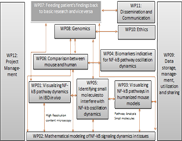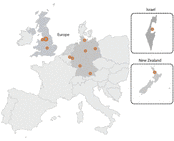WP03 - Visualising NF-kappa-B pathway dynamics in humanized mouse models
Objectives
The objective of the WP03 is to visualize the NF-kappa-B pathway in human tissue. We will use a mouse model, into which fetal human gut tissue is to be transplanted.
The specific objectives of WP03 are:
- To measure and describe steady state NF-kappa-B signalling dynamics in cells of the live human gut
- To measure and describe NF-kappa-B signalling dynamics in cells of the live human gut after induction of inflammation
- To validate candidate molecules targeting NF-kappa-B pathways in steady state and in inflamed live human gut
Workpackage Description
The objective of the WP03 is to visualise the NF-kappa-B pathway in human tissue. We will use a mouse model, into which fetal human gut tissue is to be transplanted and that will be kept alive for sufficient time as to be accessible for further analysis and it can be challenged by various human gut bacteria in order to simulate inflammation in vivo. This experimental model (which has been established and validated) will be used to determine NF-kappa-B in human gut tissue experimentally. For this after transfer of retroviral-based transgenes for the visualisation, NF-kappa-B activity dynamics will be measured by time-lapse microscopy. The retroviral-based transgenes will be developed in collaboration with UNIMAN partners. In a second step, we will develop the current transplantation model further to also includecells of the human immune system in the mouse/human chimeric system. We will then be able to visualise NFkappa-B pathway dynamics also in the human immune cells. The deliverables for WP03 are therefore, to determine NF-kappa-B dynamics for cell types of the human gut tissue before and after inflammation, to add human immune system to the transplantation model in order to study human immune cells in the same experimental system. Furtheremore, small molecules able to change NF-kappa-B dynamics will be tested in the animal model developed in WP03. Weenvisage that we will receive validated small molecules from other partners and then visualize the consequences of treatment in the transplantation model.




